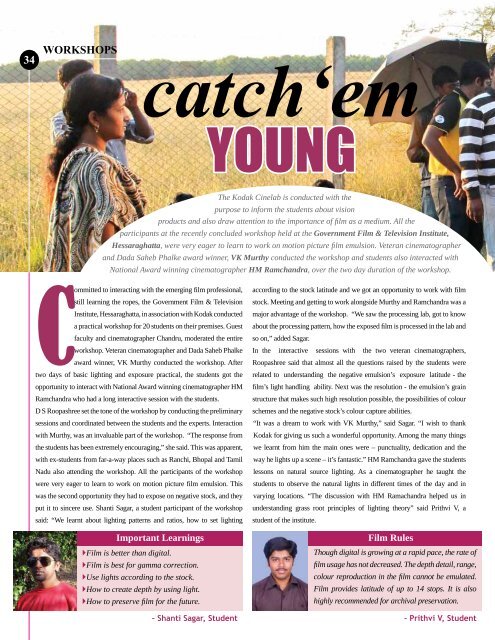READ MORE ABOUT AlsO fEATURED fOCUs ON - Kodak
READ MORE ABOUT AlsO fEATURED fOCUs ON - Kodak
READ MORE ABOUT AlsO fEATURED fOCUs ON - Kodak
You also want an ePaper? Increase the reach of your titles
YUMPU automatically turns print PDFs into web optimized ePapers that Google loves.
34<br />
WORKSHOPS<br />
catch‘em<br />
YouNG<br />
The <strong>Kodak</strong> Cinelab is conducted with the<br />
purpose to inform the students about vision<br />
products and also draw attention to the importance of film as a medium. All the<br />
participants at the recently concluded workshop held at the Government Film & Television Institute,<br />
Hessaraghatta, were very eager to learn to work on motion picture film emulsion. Veteran cinematographer<br />
and Dada Saheb Phalke award winner, VK Murthy conducted the workshop and students also interacted with<br />
National Award winning cinematographer HM Ramchandra, over the two day duration of the workshop.<br />
Committed to interacting with the emerging film professional,<br />
still learning the ropes, the Government Film & Television<br />
Institute, Hessaraghatta, in association with <strong>Kodak</strong> conducted<br />
a practical workshop for 20 students on their premises. Guest<br />
faculty and cinematographer Chandru, moderated the entire<br />
workshop. Veteran cinematographer and Dada Saheb Phalke<br />
award winner, VK Murthy conducted the workshop. After<br />
two days of basic lighting and exposure practical, the students got the<br />
opportunity to interact with National Award winning cinematographer HM<br />
Ramchandra who had a long interactive session with the students.<br />
D S Roopashree set the tone of the workshop by conducting the preliminary<br />
sessions and coordinated between the students and the experts. Interaction<br />
with Murthy, was an invaluable part of the workshop. “The response from<br />
the students has been extremely encouraging,” she said. This was apparent,<br />
with ex-students from far-a-way places such as Ranchi, Bhopal and Tamil<br />
Nadu also attending the workshop. All the participants of the workshop<br />
were very eager to learn to work on motion picture film emulsion. This<br />
was the second opportunity they had to expose on negative stock, and they<br />
put it to sincere use. Shanti Sagar, a student participant of the workshop<br />
said: “We learnt about lighting patterns and ratios, how to set lighting<br />
Important Learnings<br />
Film is better than digital.<br />
Film is best for gamma correction.<br />
Use lights according to the stock.<br />
How to create depth by using light.<br />
How to preserve film for the future.<br />
– Shanti Sagar, Student<br />
according to the stock latitude and we got an opportunity to work with film<br />
stock. Meeting and getting to work alongside Murthy and Ramchandra was a<br />
major advantage of the workshop. “We saw the processing lab, got to know<br />
about the processing pattern, how the exposed film is processed in the lab and<br />
so on,” added Sagar.<br />
In the interactive sessions with the two veteran cinematographers,<br />
Roopashree said that almost all the questions raised by the students were<br />
related to understanding the negative emulsion’s exposure latitude - the<br />
film’s light handling ability. Next was the resolution - the emulsion’s grain<br />
structure that makes such high resolution possible, the possibilities of colour<br />
schemes and the negative stock’s colour capture abilities.<br />
“It was a dream to work with VK Murthy,” said Sagar. “I wish to thank<br />
<strong>Kodak</strong> for giving us such a wonderful opportunity. Among the many things<br />
we learnt from him the main ones were – punctuality, dedication and the<br />
way he lights up a scene – it’s fantastic.” HM Ramchandra gave the students<br />
lessons on natural source lighting. As a cinematographer he taught the<br />
students to observe the natural lights in different times of the day and in<br />
varying locations. “The discussion with HM Ramachandra helped us in<br />
understanding grass root principles of lighting theory” said Prithvi V, a<br />
student of the institute.<br />
Film Rules<br />
Though digital is growing at a rapid pace, the rate of<br />
film usage has not decreased. The depth detail, range,<br />
colour reproduction in the film cannot be emulated.<br />
Film provides latitude of up to 14 stops. It is also<br />
highly recommended for archival preservation.<br />
– Prithvi V, Student

















